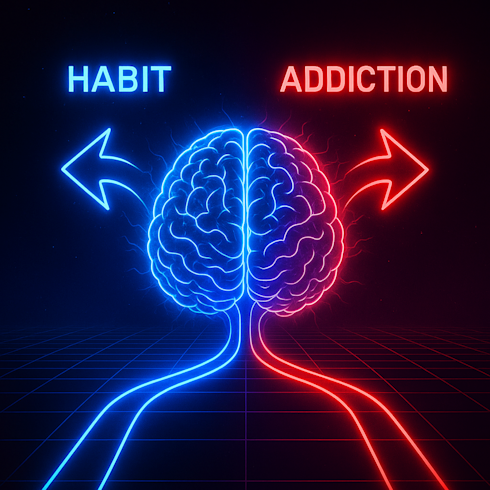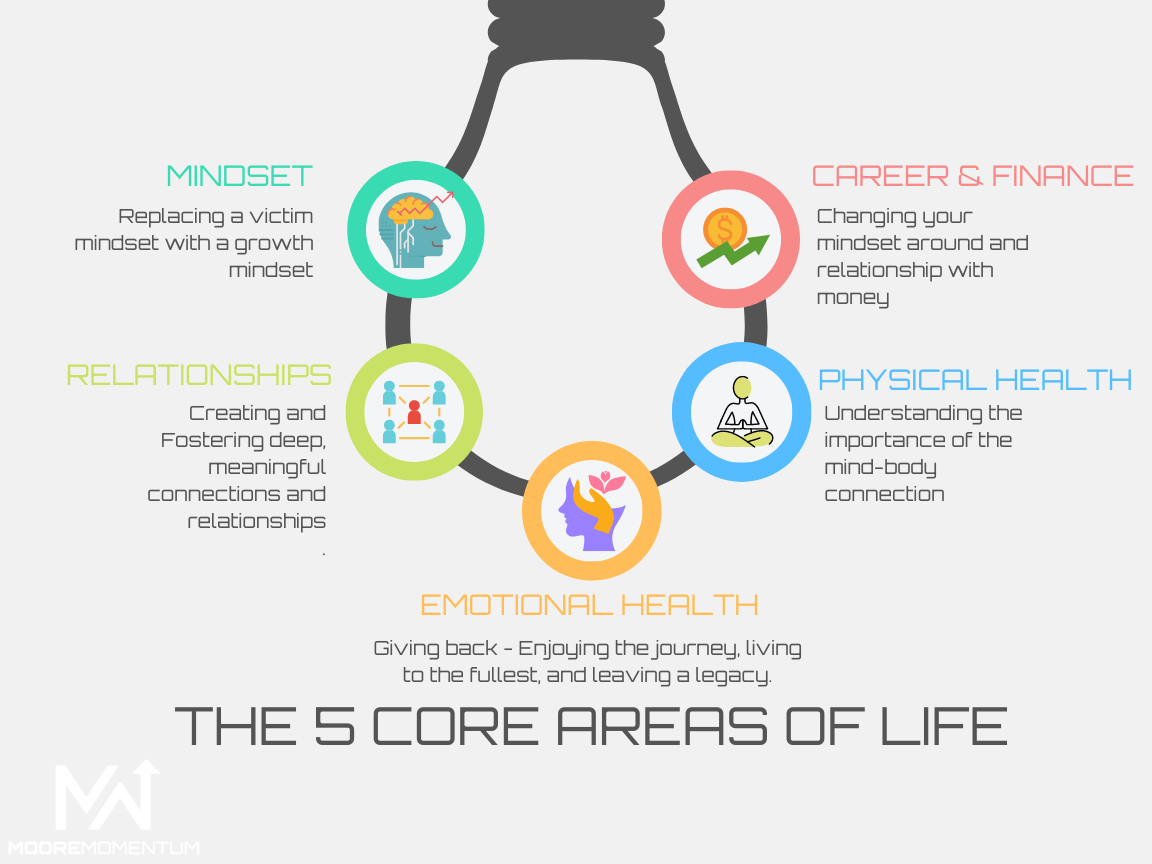
Habit vs Addiction: Everything You Need To Know
Oct 17, 2025
By Will Moore
Have you ever found yourself reaching for that extra cup of coffee in the morning and wondered, "Is this just a habit or something more?" This is where the intriguing and often misunderstood dilemma of habit vs addiction comes into play.
Is it a matter of degree, or are they fundamentally different phenomena? How do we know when a habit becomes an addiction, and what can we do to prevent or overcome it?
These are some of the questions that this article will explore, using insights from psychology, and neuroscience. You will explore how habits and addictions are formed, the key differences between habit vs addiction, how they affect our brains and behavior, and how we can change them for the better.
Habit vs Addiction:
What is a Habit?
To understand addiction vs habit let's dive into each one of these in detail. Habits are like the autopilot settings of our lives. They are the routine actions and behaviors we do almost without thinking. Ever found yourself reaching for your phone the moment you woke up? That's a habit.
These automatic actions form repeated behaviors and become ingrained in our daily routines. Habits can be as simple as brushing your teeth or as complex as the way you interact with others. They shape a significant part of our daily experiences, influencing our decisions, and ultimately, the course of our lives. Understanding habits is the first step in leveraging them to our advantage.
Read More About Different Types of Habits
How Habits are Formed?
Habit formation starts with a psychological pattern known as the 'habit loop.' This loop begins with a cue or trigger, something that signals your brain to slip into autopilot mode. Let's break the cue-reward cycle down:
Cue: It's the starting point of the habit formation. Take, for instance, the feeling of stress – it's a common trigger. It acts as a signal, prompting a specific habitual behavior, like nail-biting.
Routine: It's the core of the habit. In our example, this is the actual act of nail-biting.
Reward: This is the finish line where you receive satisfaction or relief. The sense of momentary calmness from biting your nails reinforces the habit, making it more likely to repeat in response to the same cue.
Through repetition, this cycle strengthens and the habit becomes more automatic. This process shows us that by changing our cues and rewards, we can reshape our habits.
What is Addiction?
Addiction is like being stuck in a loop also known as habit loop that's hard to break. It's when you feel a compulsive need to engage in a behavior, despite knowing it has negative consequences.
Unlike regular habits, addiction affects your brain's reward system powerfully. It can be related to substances like alcohol or drugs, or behaviors like gambling. Addiction usually starts innocently, maybe as a habit, but then takes on a life of its own, becoming a necessity rather than a choice.
Understanding this difference is crucial in distinguishing between a harmless habit and a potentially harmful addiction. However, research shows that impulsivity or genetic factors can make some people more prone to addiction than others.
Habit vs Addiction: Difference between Habit and Addiction
When we talk about habit vs addiction, it's essential to understand the profound differences between these two types of behaviors, even though they may appear similar on the surface. These examples highlight the stark contrast between habit and addiction.

1 - Control and Awareness:
Habits are actions we engage in regularly, often without much conscious thought, but crucially, they are within our control. Imagine you have a habit of drinking a cup of coffee every morning or following your morning routine checklist. You enjoy the taste, the aroma, and the energy boost it gives you. You don’t think much about it, and you can easily skip it if you want to.
Now imagine you have a cocaine addiction. You crave the drug, the rush, and the escape it provides. You can’t stop thinking about it, and you can’t function without it. You are willing to do anything to get it, even if it harms you or others.
2 - Impact on Life:
The effects of habits and addictions on our lives are markedly different. Good habits, like reading before bed, positively contribute to our well-being. They can be beneficial or at least neutral. In contrast, addictions usually lead to negative outcomes. A shopping addiction or impulse buying that causes financial problems is a classic example of how addictive behaviors can have detrimental effects on our lives.
Read More: 100 Powerful Micro Habits
3 - Dependency and Withdrawal
A key distinction lies in our body's and mind's responses to stopping the behavior. With habits, even if they're ingrained, we don't experience withdrawal symptoms if we stop them. For instance, missing your morning coffee might be disappointing, but it doesn't cause significant physical or emotional distress. However, in the case of addictions, such as nicotine dependence, stopping can lead to intense withdrawal symptoms, including physical discomfort and emotional turmoil like irritability or anxiety.
Read More: How to Stop Smoking Weed
When do Habits Become Addictions?
Addiction is a serious problem that affects millions of people around the world. As per stats, in the US alone, about 21 million Americans have at least one addiction. And it all starts with bad habits first.
Understanding habit vs addiction requires recognizing that habits become addictions when they are repeated enough to cause changes in the brain's reward and learning systems. These changes make the behavior more compulsive and less goal-directed, meaning that the person continues to do it even when it is harmful or no longer satisfying.
For example, someone who smokes cigarettes may start as a way of socializing or coping with stress, but over time, the nicotine alters the brain’s dopamine pathways and makes smoking a hard-to-break habit.
Even if the person wants to quit, they may find it very difficult to resist the urge to smoke when they see, smell, or think about cigarettes. This is because the habit has become an addiction, and the person has lost control over their behavior. Here's an interesting article talking about different bad habits examples
Patterns of Addiction: How to Recognize the Signs
Understanding addiction is a complex process that begins with recognizing its patterns. These patterns manifest as certain signs or symptoms that can indicate a possible addiction. Here are some of these signs explained
Craving: This is characterized by a powerful and often overwhelming desire for a specific substance or engaging in a particular behavior.
For instance, someone addicted to nicotine might feel a strong urge to smoke when they see others smoking or when they smell cigarette smoke. Similarly, a person with a gambling addiction might feel an intense need to gamble when they are under stress. These cravings are often triggered by environmental cues that are associated with the addictive behavior.
Loss of Control: This sign is marked by an inability to stop engaging in the addictive behavior once it has started. For example, a person with alcohol addiction might find it difficult to stop drinking once they have had their first drink. They may have initially intended to have only one drink, but find themselves unable to resist having more.
Negative Consequences: Despite facing adverse effects on their health, relationships, or work due to their addictive behavior, the individual continues to engage in it. A person addicted to a substance may continue to use it even though it is causing health problems, straining their relationships resulting in toxic relationship, or affecting their performance at work.
Tolerance: Over time, the individual needs more of the substance or needs to engage in the behavior more frequently to achieve the same effect or level of pleasure. This happens because the brain gradually adjusts to the presence of the substance or the behavior.
For example, a person addicted to caffeine may initially feel more alert after drinking one cup of coffee. However, over time, they may need to drink two or more cups to feel the same level of alertness. This is because their brain has adjusted to the presence of caffeine and now require more of it to achieve the same effect.
Remember, these are just some of the signs of addiction. If you or someone you know is exhibiting these signs, it may be time to seek professional help
Addiction Symptoms Checklist
Here's a quick checklist to identify addiction symptoms:
Do you feel an overwhelming urge to engage in the behavior?
Have you tried to stop but couldn't?
Are your relationships or work suffering because of it?
Do you keep using or doing it despite health issues?
If you answered 'yes' to these questions, it might be time to seek help and consider changing your habits.
Read More: What is Habitual Thinking
How to Break the Cycle of Harmful Addictions?
Breaking free from the cycle of harmful behaviors involves a clear understanding of its patterns and implementing effective strategies to disrupt and replace them. Here is a step-by-step process to guide you
Recognize the unhealthy habits
The first step is recognizing the addiction and its negative impact on your life. This means being honest with yourself about the extent of the problem. Keep a journal of your addictive behaviors to identify patterns and triggers.
For instance let's say excessive social media use is impacting your life negatively. This might be realized when you notice decreased productivity, strained relationships, or feeling mentally drained. Note the times of day and emotional states that prompt you to reach for your phone.
Read More: How Long Does it Take to Break an Addiction?
Understand the Trigger of Your Addictive Behavior
Identify the specific situations, emotions, or people that trigger your addictive behavior. Common triggers include stress, social environments, certain times of the day, or even specific emotions like loneliness or boredom.
In the example of social media addiction, notice if you turn to social media when you're bored, lonely, or stressed. Do certain times of the day or specific environments trigger your usage? Reflect on what you are seeking from social media. Is it validation, connection, or entertainment?
Replace the Addictive Behavior with Healthy Behavior:
Substitute the addictive behavior with healthier alternatives. For instance, replace social media time with activities like reading, exercising, or pursuing a hobby.
This replacement should offer a positive reward, reinforcing the new behavior. Reward yourself for time spent away from social media. This could be as simple as a relaxing walk after a day of reduced usage.
Develop New Coping Mechanisms:
Coping Skills: When you feel the urge to check social media, practice mindfulness or deep breathing exercises to refocus your attention.
Use Distraction Techniques: Engage in activities that require your full attention, reducing the temptation to check your phone.
Read More: How to clear your mind for meditation
Avoid Temptation:
Stay away from environments or social circles that encourage addictive behavior. Make a conscious effort to build a lifestyle that includes new hobbies and social activities.
e.g. Keep your phone in another room during work hours or during family time. Use apps that limit your social media usage or schedule specific times for checking your accounts.
Read More: Temptation Bundling
Make the process of change fun
Replacing one behavior with another may not be enough to sustain your motivation and commitment. That’s why you should make the process of change fun by adding game-like elements to your new activities.
For instance, you can set a goal to spend a certain amount of time offline each day, track your progress with a timer app, challenge yourself to do different hobbies or tasks and reward yourself for each hour you stay away from social media. By gamifying the process, you can turn your new behavior into a habit that you enjoy and look forward to.
Read More: What to Do When You Feel Like Giving Up
Create a Supportive Environment Around Yourself:
Surround yourself with people who support your journey to recovery and understand your challenges. Engage in communities or groups where positive behaviors are encouraged and practiced.
Stay Committed and Manage Relapses:
Understand that overcoming addiction is a long-term commitment and relapses can be part of the journey. Treat relapses as learning opportunities, not failures. Analyze what led to them and adjust your strategies accordingly.
Celebrate Milestones:
Recognize and celebrate your progress, no matter how small. Each achievement is a step toward breaking the cycle of addiction. Celebrating milestones reinforces positive behavior and motivates continued effort.
By following these steps, you can recognize the patterns of addiction and effectively break the cycle of negative behaviors. It's a challenging journey, but with determination, support, and the right strategies, it's possible to reclaim control over your life, build success habits, and move toward a healthier, happier future.
Read More: Why is Life Worth Living
Seeking Professional Support:
Professional help is often essential for overcoming addiction. Therapists specializing in addiction can provide evidence-based treatments like cognitive-behavioral therapy (CBT) and motivational interviewing. Medical professionals may prescribe medications to manage withdrawal symptoms and cravings. Support groups offer peer connection and accountability. Don't hesitate to reach out—recovery is possible with proper guidance.
Read More: Life Coach Vs Therapist
Final thoughts - Addiction vs Habit
While habits are routine behaviors that we perform almost unconsciously, addictions are compulsive behaviors that continue despite negative consequences. Understanding addiction vs habit is crucial—habits can be beneficial or neutral and remain under our control, whereas addictions hijack the brain's reward system and override rational decision-making. Implementing strategies like identifying triggers, replacing harmful behaviors with positive ones, and seeking support are essential for breaking the cycle of addiction and establishing healthier patterns in their place.
The Takeaway: Align Your Habits with Your Core Values
Not sure if your routine is just a habit or something more? Understanding your core values can shed light on this. By understanding where you stand in these fundamental aspects, you can better align your daily habits and tackle any addictive behaviors with a sense of purpose and direction. Our Core Values Quiz helps you see if your daily actions align with what five core areas of life: Mindset, Career & Finances, Relationships, Physical Health, and Emotional & Mental Health.

By understanding where you stand in these five cores, you can better align your daily habits and tackle any addictive behaviors with a sense of purpose and direction
Take the Core Values Quiz here
Remember, it's a straightforward step towards recognizing if your habits support your goals or if they're making you prone to addiction. Take the quiz and start aligning your life with your values today.
And there's more! Stay on track with weekly habit tracker. It's like having a friendly guide in your pocket that turns your every day into an exciting journey of growth. 🚀🚀🚀
FAQs - Habit vs Addiction
1. Which is easier to break, a habit or addiction?
Breaking a habit or addiction varies in difficulty. Habits are generally easier to break than addictions because they are more about behavior and less about physical or mental dependence. Both require effort and strategies to overcome.
2. Is addiction the same as a habit?
Addiction is not the same as a habit, though they are related. Addiction is a harmful behavior that's hard to control and negatively impacts lives. A habit is a regular behavior often done without thinking. Addiction involves habits, but not all habits lead to addiction.
3. How long does it take to break an addiction?
The time to break an addiction varies based on factors like the type and amount of substance, duration, and frequency of use, other health issues, treatment quality, and personal commitment to change. It often takes at least 90 days to overcome physical dependence, with more time needed for psychological and behavioral aspects.
4. Why is addiction bad?
Addiction is harmful because it can cause physical, mental, and social damage. It affects brain function, leading to cognitive and emotional issues, harms the body, increases disease and death risks, and negatively impacts relationships, work, finances, and legal status, causing stress and conflict.
5. What are healthy habits to replace addiction?
Healthy habits to replace addiction include exercise, meditation, journaling, cooking, gardening, spending time with family and friends, volunteering, reading, learning, and setting goals. These activities provide positive outlets for energy and emotions, improve health, and support personal and social development.
6. What is the difference between a habit and a routine?
A habit is an automatic action often done unconsciously and triggered by specific situations. A routine is a planned series of actions done intentionally. Habits can be uncomfortable to skip, while routines can be challenging or boring to perform. Motivation determines whether actions become habits. You should read our blog on Habit vs Routine.
